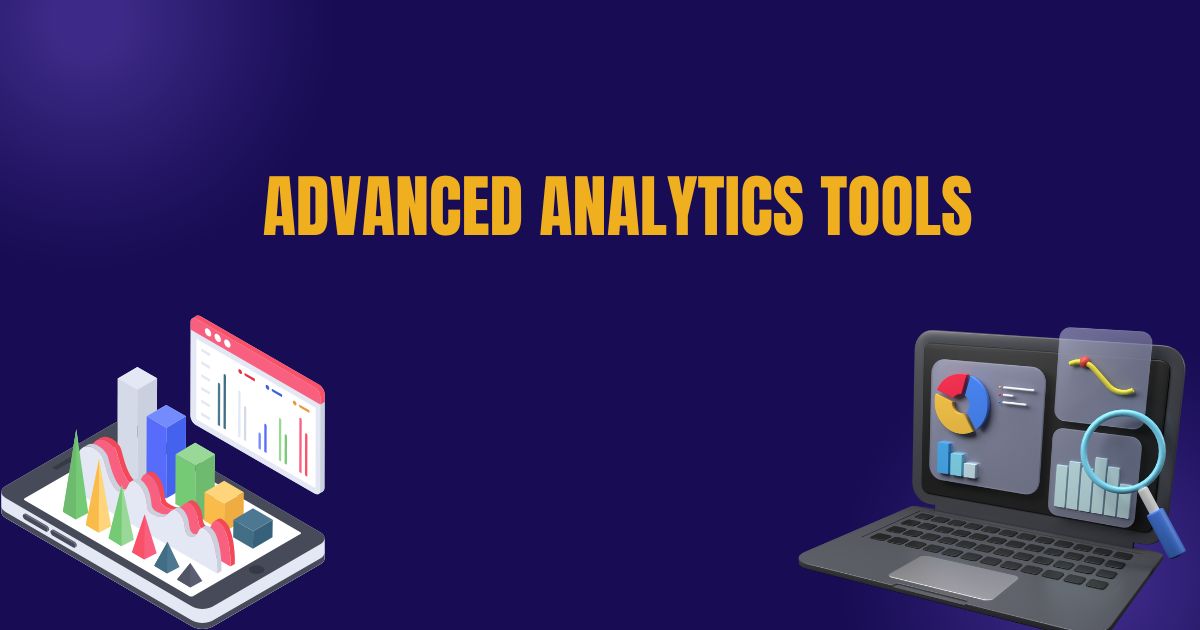Marketing teams generate massive amounts of data every day. From website traffic and social media engagement to email open rates and conversion metrics, the sheer volume of information can be overwhelming. Yet buried within this data lies the key to understanding your customers, optimizing campaigns, and driving meaningful business growth.
Advanced analytics tools have emerged as the solution to this data challenge. These platforms go beyond basic reporting to provide deep insights, predictive modeling, and actionable recommendations that can transform your marketing strategy. Whether you’re looking to improve customer segmentation, track multi-channel attribution, or predict future trends, the right analytics tool can make all the difference.
This comprehensive guide explores the world of advanced marketing analytics, helping you understand what these tools can do, how to choose the right one for your business, and how to implement them effectively. By the end, you’ll have a clear roadmap for leveraging data to drive better marketing results.
What Are Advanced Analytics Tools?

Advanced analytics tools represent a significant step up from basic reporting dashboards. While traditional analytics might show you what happened in your campaigns, advanced tools help you understand why it happened and what’s likely to happen next.
These sophisticated platforms use machine learning algorithms, statistical modeling, and artificial intelligence to process large datasets and uncover patterns that would be impossible to identify manually. They can predict customer behavior, optimize campaign performance in real-time, and provide recommendations for improving your marketing ROI.
Key capabilities of advanced marketing analytics tools include:
Predictive Analytics: Using historical data to forecast future outcomes, such as which leads are most likely to convert or when customers might churn.
Customer Journey Mapping: Tracking interactions across multiple touchpoints to understand how customers move through your sales funnel.
Attribution Modeling: Determining which marketing channels and campaigns deserve credit for conversions, especially in complex multi-touch scenarios.
Cohort Analysis: Grouping customers based on shared characteristics or behaviors to identify trends and patterns over time.
Real-time Optimization: Automatically adjusting campaigns based on performance data to maximize results.
Why Marketing Analytics Matter More Than Ever
The marketing landscape has become increasingly complex. Customers interact with brands across multiple channels, from social media and email to websites and mobile apps. This fragmentation makes it challenging to understand the complete customer journey and measure the true impact of marketing efforts.
Advanced analytics tools address these challenges by providing a unified view of customer interactions and marketing performance. They help marketers answer critical questions like:
- Which marketing channels drive the highest-quality leads?
- What content resonates most with different customer segments?
- How can we optimize our marketing spend for maximum ROI?
- Which customers are at risk of churning, and how can we retain them?
Companies that embrace data-driven marketing see significant benefits. Organizations using advanced analytics are five times more likely to make faster decisions and three times more likely to execute decisions as intended compared to their peers.
Types of Advanced Analytics Tools
The market offers various types of advanced analytics tools, each designed to address specific marketing challenges and use cases.
Web Analytics Platforms
These tools go beyond basic website traffic reporting to provide deep insights into user behavior, conversion paths, and content performance. Advanced features include heat mapping, user session recordings, and funnel analysis.
Leading platforms in this category offer sophisticated segmentation capabilities, allowing marketers to analyze behavior patterns across different customer groups. They can track micro-conversions, identify drop-off points in the conversion process, and provide recommendations for optimization.
Customer Data Platforms (CDPs)
CDPs unify customer data from multiple sources to create comprehensive customer profiles. These platforms excel at managing complex datasets and providing a single source of truth for customer information.
Advanced CDPs use machine learning to identify customer segments automatically, predict lifetime value, and recommend personalized experiences. They integrate with marketing automation tools to enable real-time personalization across all touchpoints.
Marketing Attribution Tools
Attribution tools help marketers understand which touchpoints contribute to conversions in multi-channel campaigns. They use sophisticated modeling techniques to assign credit across the customer journey.
Modern attribution platforms can handle complex scenarios involving online and offline touchpoints, long sales cycles, and multiple decision-makers. They provide insights that help optimize budget allocation and campaign strategies.
Predictive Analytics Platforms
These tools focus specifically on forecasting future outcomes based on historical data. They can predict customer behavior, campaign performance, and market trends.
Predictive platforms often include automated machine learning capabilities, making advanced analytics accessible to marketers without extensive technical expertise. They can identify at-risk customers, predict optimal send times for campaigns, and forecast demand for products or services.
Key Features to Look For
When evaluating advanced marketing analytics tools, several key features separate the leaders from the pack.
Data Integration Capabilities
The best tools can connect to multiple data sources, including CRM systems, marketing automation platforms, social media channels, and advertising networks. Look for pre-built connectors and APIs that make integration straightforward.
Robust data integration ensures you have a complete view of your marketing performance without manual data compilation. The tool should handle different data formats and provide data cleansing capabilities to ensure accuracy.
User-Friendly Interface
Advanced doesn’t have to mean complicated. The most effective tools balance sophisticated analytical capabilities with intuitive interfaces that non-technical users can navigate easily.
Look for drag-and-drop report builders, customizable dashboards, and clear visualizations that make complex data accessible to your entire marketing team. The tool should offer different views for different user types, from executives who need high-level summaries to analysts who require detailed data exploration.
Real-Time Processing
Marketing moves fast, and your analytics tools should keep pace. Real-time data processing allows you to monitor campaign performance as it happens and make adjustments on the fly.
This capability is particularly important for paid advertising campaigns, where small optimizations can have a significant impact on ROI. Look for tools that can process data streams in real-time and trigger automated actions based on performance thresholds.
Customization and Flexibility
Every business has unique requirements, and your analytics tool should adapt to your specific needs. Look for platforms that offer customizable metrics, flexible reporting options, and the ability to create custom calculations.
The tool should also allow you to set up automated alerts and reports that keep stakeholders informed without manual intervention. Custom attribution models and the ability to define unique conversion events are also valuable features.
How to Choose the Right Tool for Your Business
Selecting the right advanced analytics tool requires careful consideration of your business needs, technical requirements, and growth plans.
Assess Your Current State
Start by auditing your existing analytics setup. What tools are you currently using? What gaps exist in your data collection and analysis? Understanding your starting point helps identify the specific capabilities you need in an advanced tool.
Consider your team’s technical expertise. If you have limited data science resources, prioritize tools with strong automation and user-friendly interfaces. Organizations with dedicated analytics teams might benefit from more flexible platforms that allow custom modeling and analysis.
Define Your Use Cases
Different tools excel in different areas. Clearly define what you want to achieve with advanced analytics. Are you primarily focused on attribution modeling, customer segmentation, predictive analytics, or real-time optimization?
Create a prioritized list of use cases and evaluate tools based on their ability to address your top priorities. Remember that you don’t need to solve every analytics challenge at once – focus on the areas that will have the biggest impact on your business.
Consider Integration Requirements
Your analytics tool needs to work within your existing technology stack. Evaluate how well potential solutions integrate with your CRM, marketing automation platform, advertising tools, and other systems.
Poor integration can lead to data silos and manual processes that reduce the value of your investment. Look for tools with robust APIs and pre-built connectors to your essential systems.
Evaluate Scalability
Choose a platform that can grow with your business. Consider factors like data volume limits, user restrictions, and feature availability across different pricing tiers.
Think about your analytics needs 12-18 months from now. Will the tool handle increased data volumes? Can it support additional use cases as your team becomes more sophisticated? Switching analytics platforms later can be disruptive and expensive.
Implementation Best Practices
Successfully implementing advanced analytics tools requires more than just technical setup. Follow these best practices to maximize your investment and drive adoption across your organization.
Start with Clean Data
The quality of your insights depends on the quality of your data. Before implementing any advanced analytics tool, audit your data sources and clean up inconsistencies.
Establish data governance processes to maintain quality over time. Define naming conventions, create data dictionaries, and implement validation rules to prevent future data quality issues.
Begin with Pilot Projects
Don’t try to implement every feature at once. Start with one or two high-impact use cases and demonstrate value before expanding your usage.
Pilot projects help you learn the tool’s capabilities while building confidence within your organization. Choose use cases where you can measure clear business impact and communicate results effectively.
Invest in Training
Advanced analytics tools are only valuable if your team knows how to use them effectively. Invest in comprehensive training that goes beyond basic functionality to cover analytical thinking and interpretation of results.
Consider creating internal champions who can become power users and help train other team members. Many vendors offer certification programs that can help your team develop expertise.
Establish Governance
Create clear processes for accessing data, creating reports, and sharing insights. Establish guidelines for data security and privacy compliance, especially if you’re handling customer data.
Define roles and responsibilities for maintaining the system, updating configurations, and monitoring data quality. Good governance prevents issues before they impact your analysis.
Measuring Success and ROI
To justify your investment in advanced analytics tools, you need to measure their impact on your marketing performance and business results.
Define Success Metrics
Identify specific KPIs that will demonstrate the value of your analytics investment. These might include improved conversion rates, reduced customer acquisition costs, increased marketing ROI, or faster decision-making.
Set baseline measurements before implementation so you can track improvement over time. Document the manual processes and time investments that the tool will replace.
Track Adoption Metrics
Monitor how your team uses the analytics tool. Low adoption rates indicate training gaps or usability issues that need to be addressed.
Track metrics like active users, report creation frequency, and the percentage of marketing decisions backed by data from the platform.
Calculate Financial Impact
Quantify the financial benefits of your analytics tool wherever possible. This might include revenue attributed to optimization recommendations, cost savings from automated processes, or improved efficiency in campaign management.
Consider both direct financial benefits and indirect value like improved customer satisfaction or reduced risk from better decision-making.
Taking Your Marketing Analytics to the Next Level

Advanced analytics tools represent a significant opportunity to improve your marketing effectiveness and drive business growth. The key is choosing the right platform for your needs and implementing it thoughtfully.
Start by clearly defining your analytics goals and evaluating tools based on their ability to address your specific use cases. Remember that successful implementation requires more than just technology – invest in training, establish good governance practices, and focus on demonstrating clear business value.
As your team becomes more comfortable with advanced analytics, you’ll discover new opportunities to optimize your marketing efforts and better serve your customers. The insights you gain will not only improve your current campaigns but also inform your overall marketing strategy.
Ready to transform your marketing with advanced analytics? Begin by auditing your current analytics setup and identifying the biggest gaps in your data insights. This foundation will guide your tool selection and ensure you choose a platform that delivers real business value.
